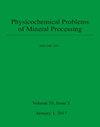电子垃圾生物浸出的最新可持续发展趋势
IF 1.2
4区 工程技术
Q4 CHEMISTRY, PHYSICAL
引用次数: 0
摘要
在过去的几十年里,电子和电气垃圾一直在我们的土地上堆积,不仅对我们的环境和健康构成了严重威胁。随着技术的进步以及电子需求和生产的快速增长,在我们的荒地上积累更多未使用的有价值的可用材料的风险。欧盟预测,到2030年,约有7400万吨电子垃圾,包括洗衣机、平板电脑、烤面包机和手机。2022年,超过53亿部手机被浪费,而从电线、电池到组件的许多金属部件中都含有锂、锰、铜、镍和各种稀土元素(如Nd、Eu和Tb等)以及石墨。除环境方面外,主要目的是保留这些废物中使用的矿物,因为许多关键材料的供应风险严重依赖进口。例如,这些稀土元素中的许多来源于中国;这些稀土元素被用于从消费品到工业机器的许多电子产品中。这项研究旨在审查一种理想的方法,即使用生物技术从多氯联苯、废电池和LCD/LED面板等主要电子废物来源中尽可能多地溶解和回收。第二部分对用于生物浸出过程的微生物及其金属回收方面进行了比较。考虑到重大的技术、经济、环境和社会影响,最终增加了未来展望。本文章由计算机程序翻译,如有差异,请以英文原文为准。
Recent sustainable trends for e-waste bioleaching
For the past few decades, the electronic and electrical waste have been accumulating and piling on our lands and aside from posing some serious threat on our environment and our health. And with the technological advance and the rapid growing electronic demand and production there is the risk of accumulating even more unused valuable usable materials in our waste land-fields. Up to 2030, EU is forecasting about 74 million tons of e-waste, including washing machines, tablet computers, toasters, and cell phones. In 2022, more than 5.3 billion mobile phones were wasted whereas Li, Mn, Cu, Ni, and various rare-earth elements (like Nd, Eu and Tb, etc.) as well as graphite are actually found in the contents of many metal parts from wiring, batteries to their components. The main purpose aside from an environmental aspect is reserving the mineral used in this waste, as many of the crucial materials have a supply risk heavily depending on import. For instance, many of these rare earth elements (REE) are sourced from China; these REEs are used in many electronics that range from consumer products to industrial-use machines. This study is to review one of the desired methods that is via using bio-techniques to dissolve and recover as much as possible from main e-waste sources such as PCBs, spend batteries and LCD/LED panels. Microorganisms that are used for bioleaching process and their metal recovery aspects were compared in the second part. Future perspectives were finally added considering significant techno-economic environmental and social impacts.
求助全文
通过发布文献求助,成功后即可免费获取论文全文。
去求助
来源期刊

Physicochemical Problems of Mineral Processing
CHEMISTRY, PHYSICAL-MINING & MINERAL PROCESSING
自引率
6.70%
发文量
99
期刊介绍:
Physicochemical Problems of Mineral Processing is an international, open access journal which covers theoretical approaches and their practical applications in all aspects of mineral processing and extractive metallurgy.
Criteria for publication in the Physicochemical Problems of Mineral Processing journal are novelty, quality and current interest. Manuscripts which only make routine use of minor extensions to well established methodologies are not appropriate for the journal.
Topics of interest
Analytical techniques and applied mineralogy
Computer applications
Comminution, classification and sorting
Froth flotation
Solid-liquid separation
Gravity concentration
Magnetic and electric separation
Hydro and biohydrometallurgy
Extractive metallurgy
Recycling and mineral wastes
Environmental aspects of mineral processing
and other mineral processing related subjects.
 求助内容:
求助内容: 应助结果提醒方式:
应助结果提醒方式:


